The Bats of Abidjan
Millions of bats flying in the late afternoon sky. Or at least that's what we thought we were seeing. It turns out this flock numbered just under 200,000, according to research (Niamien, C., et al. "Données préliminaires sur l’écologie des chauves-souris frugivores de la commune du Plateau (Abidjan, Côte d’Ivoire)." ) Sciences & Nature 7.1 (2010)) carried out in 2005-6.
And thanks to the research and subsequent papers prepared by Messrs Niamien et al, I've learned quite a bit about the rather appealing looking eidolon helvum, or straw-coloured fruit bat.
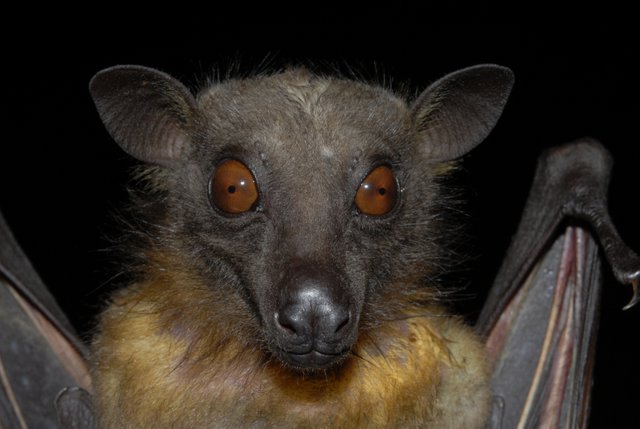
I was in Abidjan, the commercial capital of the West African country Côte d’Ivoire, for a few days in November 2015, participating in the inaugural "PIDA Week", or the first week dedicated to bringing together public and private sector players to tackle the meaty challenge of the Programme for Infrastructure Development in Africa (PIDA), hosted by the African Development Bank at their headquarters in the city.
After serious days of deliberation on how to crack Africa's lack of cross-border regional infrastructure, we would head outside to get to our various evening engagements - and inevitably the eyes would stray upwards in wonder at the spectacle of these bats. They fly fast and are extremely difficult to photograph - particularly with a little Samsung S5 like mine at the time, and especially when the photographer herself had so little skill...which is why the best photo I managed to get of the flock looks like this.
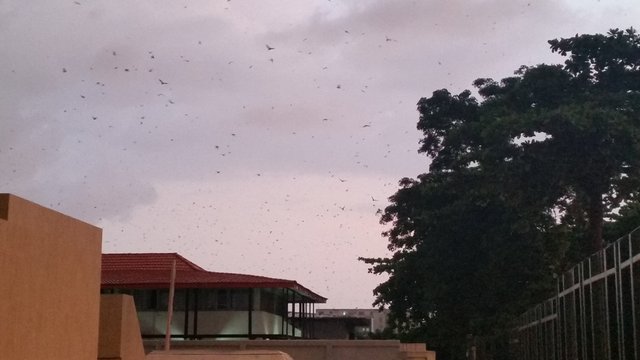
As you can imagine, while we were a group eminently capable of talking about solving Africa's infrastructure challenges, none of us was that clued up on the bats of Abidjan. We wondered if they were insect eaters, as we couldn't figure out how there could possibly be so much food in an urban environment to support what we thought were millions of animals. But if they were insect eaters, why were there so many blasted bugs? And clearly they weren't vampire bats, or people would be shooting them down from the sky. Like the bats, we engaged in a few flights of fancy ourselves.
So when guesswork fails, look it up.
Fast facts I've since gleaned about Abidjan's Commune du Plateau bat colony residents:
- they're fruit eaters ("frugivores", in French - a lovely word), mostly eating mangoes
- they roost in colonies in a couple of different kinds of trees, having a marked preference for a specific type of mango tree
- they're vulnerable to poaching by the locals - apparently people like to eat them
- a favourite hunting method is the simple slingshot
- in response, they cluster close to the Police headquarters, the National Assembly and certain high-security private houses where the likelihood of being poached is lower
- they were (probably) falsely accused in 2014 of being a vector for the Ebola virus to reach humans - mostly I suspect it's just gross if you're walking under a mango tree and one or more decides it's a good time to evacuate the bat bowels onto your head or shoulders - but that did make people bats--t crazy scared at the time, if you get my drift
- It makes sense for them to live close by their food source, as their flying is energy-intensive
- they have a rare bat cousin, the hammer-headed bat or delightfully Latin named Hypsignathus monstrosus (sounds a bit unfair, don't you think?), living with them in the Commune du Plateau.
Some closeup views by more expert photographers follow.
This view highlights their lustrous straw colouring.
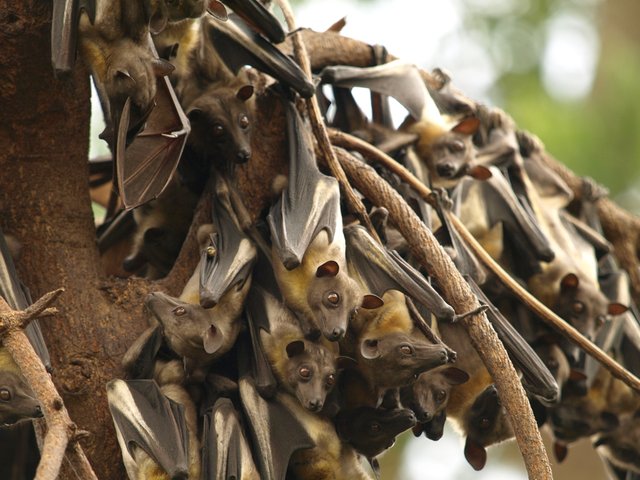
Attribution:
By Konrad Bidziński (Own work) [CC BY-SA 4.0 (http://creativecommons.org/licenses/by-sa/4.0)], via Wikimedia Commons
Here you can clearly see their feet:
Attribution:
By Fritz Geller-Grimm (Own work) [CC BY-SA 2.5 (http://creativecommons.org/licenses/by-sa/2.5) or CC BY-SA 2.5 (http://creativecommons.org/licenses/by-sa/2.5)], via Wikimedia Commons
And here's a terrific close-up shot of an individual hanging in its roost:
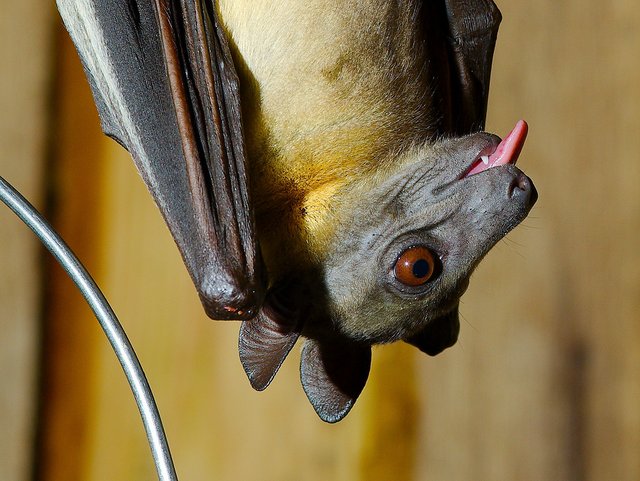
Their range in Africa is impressive - I didn't realise they were native to South Africa as well:
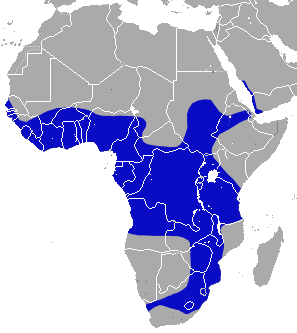
Attribution:
IUCN Red List of Threatened Species, species assessors and the authors of the spatial data. [CC BY-SA 3.0 (http://creativecommons.org/licenses/by-sa/3.0)], via Wikimedia Commons
So I went to Abidjan to talk infrastructure and learned some unexpected bat facts. Serendipity!
@Kiligirl love your content, activities on steemit and your positive vibe.
Incase ya'll didn't know @kiligirl is one of the best people to be friends with. Follow her for some positivity. It's just a click away.
Wow, @simeonburke, you made my evening! It's people like you who are making my Steemjourney so enjoyable. Thank you so much 🤗🤗🤗.
@kiligirl, just being sincere. I say it how it is and you can notice it in my blogs. I still remember your homegirl's intro when I commented on it.
Now it's trending! Who doesn't want friends that have positive vibes? Good people never go unnoticed. Keep it up! I am rooting for you anytime and any day.
I really appreciate it.
Have a few hours of free time each week?? Why not use it to earn some money online? Learn more here-> >http://Path70.com
Aw yeah, them bats get around! Enjoy your time there, interested to read more about PIDA. We're working locally with the San Diego Diplomacy Council, who is currently hosting a couple of African entreprenuers. One of them is job shadowing us at Paleo Treats on the 12th, and I think we're heading over to USD tonight for a panel on Innovation, Empowerment, and Servant Leadership led by a few of the entreps. Stoked!
Cool! Great to see someone on the platform is familiar with PIDA (colour me gobsmacked ;-)). I got sidelined from PIDA in my previous role but am hoping to get back into it, as it has the potential to unlock intra-African trade, which we sorely need on the continent.
Look forward to any news you might post about the University of San Diego's event. Enjoy!
Well, I won't say I'm familiar with PIDA, but I'll definitely check 'em out. Always interested to learn about new things!
Look at it as a work in progress ;-).
no matter how we put it...here in my country we have this notion that bats signifies bad omen but hey...am not superstitious...but still...they mainly stay in caves...nice pictures of bats you have there...nice work
Thanks, @kenhudoy.
These bats are pretty darn cute and I am in love with the last photo! Thanks to you, I also learned some unexpected bat facts ;)
I thought it was really goofy and captured how I often feel 🙃😜😏. And bat facts! Great expression.
Haha 😂🦇
Now that is a lot of bats! They're such amazing creatures that few people understand. I'm glad you were able to enjoy the view and learn more about them along the way :)
Thanks, @cryptodata!
Congratulations @kiligirl! You have completed some achievement on Steemit and have been rewarded with new badge(s) :
Click on any badge to view your own Board of Honnor on SteemitBoard.
For more information about SteemitBoard, click here
If you no longer want to receive notifications, reply to this comment with the word
STOPBy upvoting this notification, you can help all Steemit users. Learn how here!
These pictures are great, they actually don't look so bad if you see them up close. I am always a bit scared of them "don't want them to get stuck in my hair" I now know that that is not possible because they are very accurate flyers. Thank you for this informative post.
Thanks, @stardust! I've always thought fruit bats were kinda cute :-)
They actually do look kind of cute :-)
Lol
Some people cringe when they see bats. All bats fear Ozzy Osbourne.
As they should - the bats, I mean 😂
Did you know? Bats are dogs with wings?
Splort! But yes, they do look like tiny Jack Russells, don't they?
you bet! In fact, I always dress up my dog as a bat every holloween lol
Lol
I never liked these creatures :D